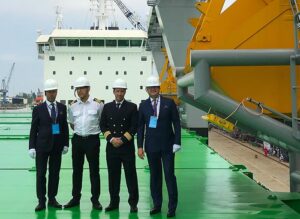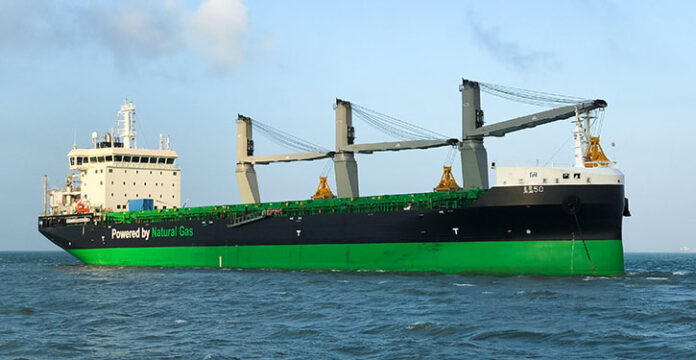The next-generation bulk carrier MV HAAGA has recently been delivered to ESL Shipping from Jinling Shipyard in Nanjing, China. ESL Shipping is part of the Aspo Group (based in Helsinki). The 160-meter, 25,600 dwt, natural gas-fueled vessel generates less than 50% of the carbon dioxide emissions compared to the previous generation of vessels. MV HAAGA as well as their sister vessel MV VIIKKI, both are the first gas-powered handy-size bulker in the world, can also be fueled by completely carbon-free biogas, once the availability of carbon-free biogas improves over time.
The two newbuilding incorporate several innovative solutions to reduce its environmental footprint by minimizing its energy consumption and emissions.
The main innovations
* Energy Efficiency Design Index (EEDI) of the vessels is approximately 50% below the current requirement and already fulfilling the 2025 requirements.
* All engines and boiler burner operate on natural gas. Vacuum insulated IMO type C tank with low boil off generation rate.
By the way: VIIKI and HAAGA feature on both sides of the hull the writing: Powered by Natural Gas. The company has understood that LNG (Liquid Natural Gas) is not the fuel to create energy: It goes without saying that the engines burn pure natural gas (methane)!
* The DNV GL Clean Design notation: The notation requires special features such as 5 ppm bilge water separator, biofouling management, ODP = 0 (Ozone depletion potential), GWP max 1300 (Global warming potential)
* Hydrodynamic hull form: Extensive CFD-calculations and model testing was performed to optimize the hull form. The bow and stern thruster tunnel openings are provided with scallops and streamline grids. Special attention for monitoring of hull surface roughness was done during the building stage.
* The hull is painted with low friction ice-resistant paint. No harmful antifouling paint is used. Frequent hull cleaning will be performed to reduce the drag of the hull.
* The ships can perform operations in port on shore-electricity, reducing emissions in port up to 100%.
* A permanent magnet PTI/PTO shaft generator with VFD drive enables flexible and efficient operation of propulsion and power generation at sea as well as extra power for ice conditions through power take in/power take out shaft generator.
* ESL and MacGregor, which is part of Cargotec, have developed the world’s first autonomous cargo handling solution for the vessel to further improve safety and efficiency.
The propulsion system
A Multi-fuel 5-cyl STX-MAN engine of type 5G45ME-C9.5-GI Tier II, creates 6.000 kW + PTI boost 1.250 kW, in total 7.250 kW. This energy is transmitted to a special designed rudder and propeller arrangement to enable low consumption. The vessel is optimized for a service speed of 12 kn. Maximum speed at open sea is about 16 kn.
A special eye has been put on the emissions:
As the company says: reduction of direct exhaust emissions with natural gas compared to 0.1 % fuel oil are:
* 57 % for CO2 emissions
* 92 % for SOx emissions
* 25 % for NOx emissions
* 98 % for PM emissions
Readers may wonder about these results – but Mikki Koskinen, Managing Director of ESL Shipping explains: “First of all we are comparing the total energy consumption and emissions derived thereof between a vessel built in 2006 and our newbuilding, the older vessel burning 0,1 % fuel oil and the newbuilding burning gas. We are not comparing emissions produced by unit of gas or 0,1 % fuel oil, we are comparing two vessels of which the newbuilding has very low total energy consumption. The comparison cycle include not only the use of main engine but also use of auxiliary engines in port. The calculation however does not include our possibility of using also shore power in port, which depending on how shore electricity is produced could produce even less emissions”.
The Deltamarin-designed rudder is equipped with bulb and end plates to optimize the flow from main shaft to rudder. In addition, there are four stator fins both in the main shaft in order to improve current to the propeller which has a diameter of six meters. Bow and stern thruster openings have scallops and grids that improve hydrodynamics.
Electrical power is created by 3 x Dual Fuel MAN 23/30 engines. Two of them deliver each 950 kW and the remaining delivers 625 kW. The speed of the gensets is 750 r/min.
For better and precise manoeuvring two thrusters are installed: One 1000 kW at the foreend and one 700 kW at the aftend of the vessels.
The LNG-storage tank

As mentioned before all engines and boiler burner operate on natural gas. To provide and ensure enough primary energy a LNG-storage tank, which is a vacuum insulated IMO type C tank with low boil off generation rate, has been installed on the aft deck of the vessels, which features a content capacity of around 390 m3. According to the company this LNG amount is enough to navigate the vessel at their service speed of 12 kn for about 14 days before next bunkering, which will take place by trucks somewhere in Scandinavia.
Koskinen says: “Our new vessels have met with an excellent reception among our customers. Every employee of our shipping company should be genuinely proud of what we have achieved during our newbuilding project”, and added: “The completion of the new vessels will have a positive effect on the shipping company’s profitability and competitiveness”.
And Aki Ojanen, CEO of Aspo Plc and Chairman of the Board of Directors of ESL Shipping, says: “This investment of around EUR 60 million is significant for a company of Aspo’s size. It’s also an excellent example of our responsible ownership, as environmental responsibility involves considering future generations, too. The design and construction of the new vessels were completed as planned. The vessels will considerably increase ESL Shipping’s capacity, in addition to improving its profitability”.
This newbuilding project is part of the Bothnia Bulk project, partly funded by the EU. Its goal is to modernize the sea route between Luleå, Oxelösund and Raahe to be more eco-friendly. In addition, environmental emissions will decrease at port with the improved availability of shore-side electricity. The vessels have been designed by Deltamarin in Finland, and European equipment suppliers have provided roughly 60 percent of all vessel systems.




